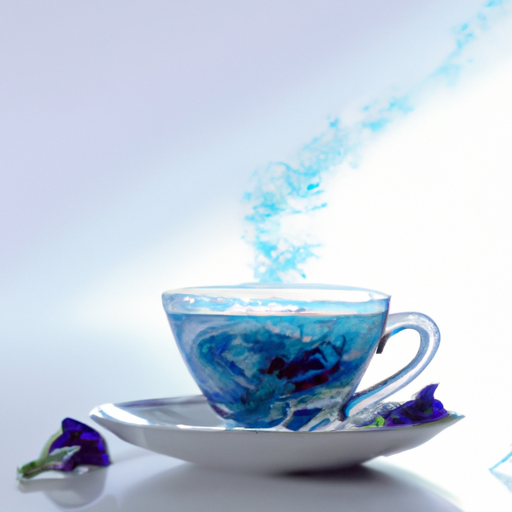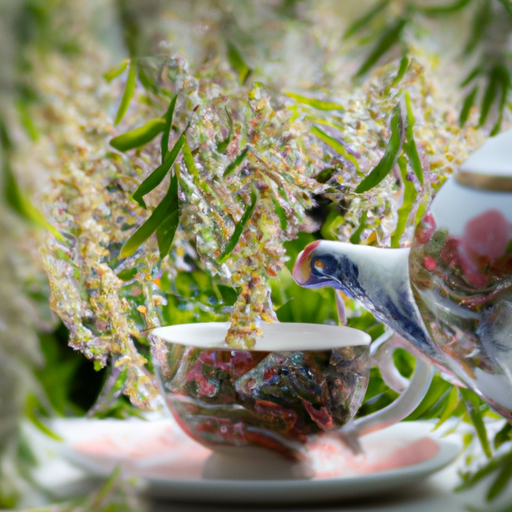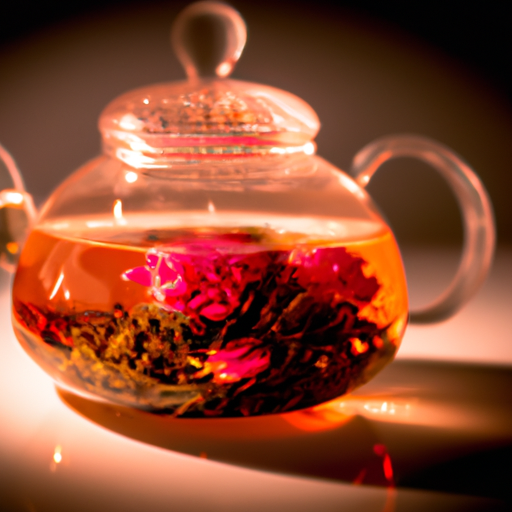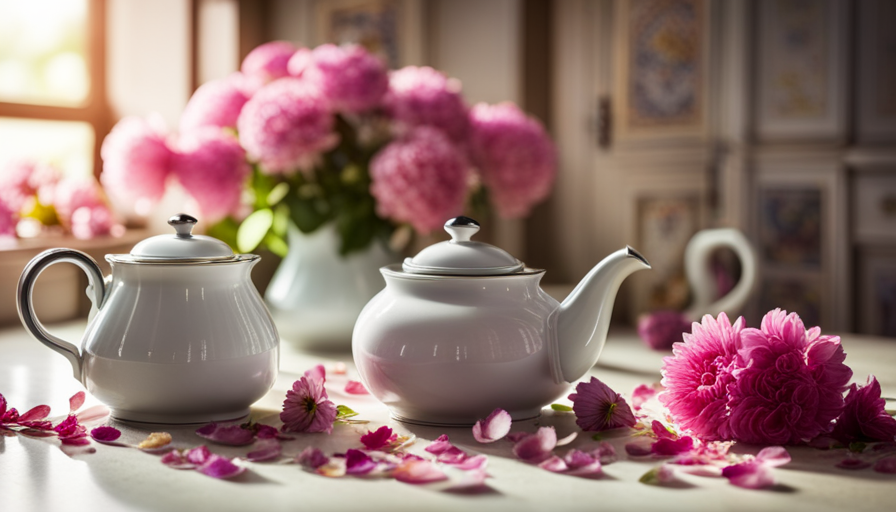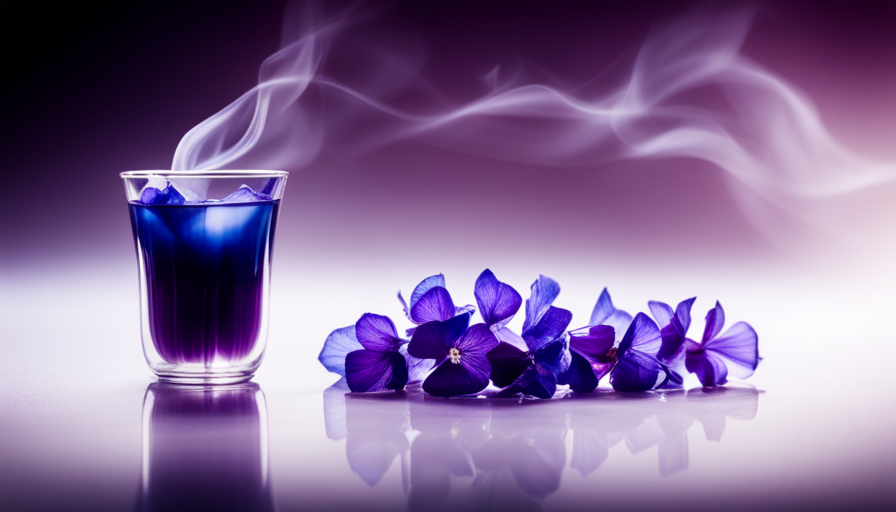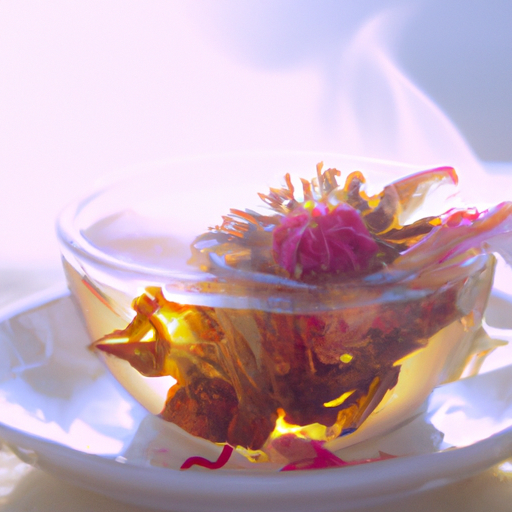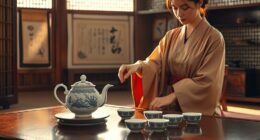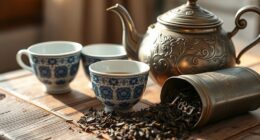Imagine a delicate symphony of flavors dancing on your taste buds, a sensory experience that is both enchanting and captivating.
This is the magic of butterfly pea flower tea. Like a graceful ballet of petals unfurling in a sunlit garden, this exquisite tea offers a journey of taste unlike any other.
As I took my first sip, I was transported to a realm of pure delight, where floral notes intertwine with subtle hints of earthiness, creating a harmonious balance that is both refreshing and soothing.
The vibrant blue hue of the tea adds a touch of elegance to every cup, inviting you to indulge in its beauty. With each sip, I was captivated by the enchanting melody of flavors that lingered on my palate, leaving a lingering sweetness that beckons for another sip.
Join me on a sensory adventure as we explore the fascinating taste of butterfly pea flower tea and uncover the secrets hidden within its petals.
Key Takeaways
- Delicate flavors and captivating aromas
- Mild and earthy flavor with subtle floral undertones
- Versatile and can be enjoyed hot or cold
- Offers health benefits including antioxidants and stress relief
Origins and History of Butterfly Pea Flower Tea
Butterfly pea flower tea, with its vibrant blue color and rich cultural heritage, has been enjoyed for centuries in Southeast Asia. The origins and history of this tea are deeply rooted in the region’s cultural significance and traditions.
The butterfly pea flower, scientifically known as Clitoria ternatea, has long been used in traditional medicine and cuisine, but it’s the infusion of its petals that creates the stunning blue tea that has captured the attention of tea connoisseurs worldwide.
In Southeast Asia, butterfly pea flower tea holds great cultural significance. It’s often used in special ceremonies and celebrations, symbolizing purity, tranquility, and good fortune. The tea has been passed down through generations, with each family having their unique way of preparing and serving it. It’s not just a beverage but a part of the local cultural fabric, representing the rich history and traditions of the region.
The deep blue color of the tea is one of its most striking features. When steeped, the petals release a beautiful indigo hue that is both visually captivating and a testimony to the tea’s natural goodness. As for its aroma, butterfly pea flower tea exudes a delicate floral scent with hints of earthiness, creating a sensory experience that’s both soothing and invigorating.
Transitioning to the subsequent section on appearance and aroma, the allure of butterfly pea flower tea extends beyond its origins and history.
Appearance and Aroma of the Tea
The vibrant blue hue of the brew catches the eye, while the floral scent wafts gently from the cup. As I take a moment to appreciate the appearance and aroma of butterfly pea flower tea, I’m immediately captivated by its unique qualities.
Here are a few sensory details that paint a vivid picture in my mind:
-
The tea is a stunning shade of blue, reminiscent of a clear summer sky. Its color changing properties add a touch of whimsy, as it transforms into a vibrant purple when lemon juice is added.
-
The delicate petals of the butterfly pea flower unfurl in the hot water, releasing their enchanting fragrance. It’s a delightful blend of floral notes, with hints of jasmine and orchids, that lingers in the air.
-
As I bring the cup closer to my nose, I’m greeted by a subtle sweetness that complements the floral bouquet. It’s a pleasant surprise and adds depth to the overall experience.
-
Sipping the tea, I’m met with a gentle and refreshing taste. The flavor is delicate and smooth, with subtle earthy undertones that balance the floral notes perfectly.
Transitioning to the subsequent section on the flavor profile of butterfly pea flower tea, one can’t help but be intrigued by its captivating appearance and enticing aroma.
Flavor Profile of Butterfly Pea Flower Tea
Indulging in a sip of this enchanting brew is like embarking on a sensory journey that awakens the palate with its delicate and refreshing notes. Butterfly pea flower tea offers a unique flavor profile that’s both intriguing and satisfying. The tea boasts a mild, earthy taste with subtle floral undertones that dance on the tongue. Its flavor characteristics are reminiscent of green tea, with a hint of grassiness and a gentle sweetness that lingers after each sip.
What makes butterfly pea flower tea even more fascinating is its ability to change color when combined with certain ingredients like lemon juice or lime. This natural reaction adds an element of surprise to the overall taste experience. The vibrant blue hue of the tea transforms into a lovely purple shade, further enhancing its visual appeal.
When it comes to taste preferences, butterfly pea flower tea is versatile and can be enjoyed both hot and cold. It can be consumed on its own for a soothing and calming experience or mixed with other ingredients to create unique and refreshing beverages. Whether you prefer a hot cup of tea to unwind or a chilled infusion on a summer day, this tea offers a delightful flavor that caters to a wide range of palates.
Transitioning into the subsequent section about the health benefits of butterfly pea flower tea, this captivating brew not only pleases the taste buds but also nourishes the body with its numerous advantages.
Health Benefits of Butterfly Pea Flower Tea
Immerse yourself in the world of wellness as you discover the myriad health benefits that await you with a single sip of this magical brew. Butterfly pea flower tea isn’t just a feast for the eyes with its stunning blue hue, but it also offers a range of health benefits that can enhance your overall well-being.
Here are three sub-lists to paint a picture of the health benefits of butterfly pea flower tea:
-
Antioxidant Powerhouse: Packed with antioxidants, this tea helps fight against free radicals, reducing the risk of chronic diseases and promoting healthy aging.
-
Stress Relief: The tea contains natural compounds that’ve been found to possess anxiolytic properties, helping to calm the mind and promote relaxation.
-
Digestive Aid: Known for its anti-inflammatory properties, butterfly pea flower tea can soothe the digestive system, alleviate stomach discomfort, and promote healthy digestion.
In addition to its health benefits, butterfly pea flower tea is also renowned for its color-changing properties. When lemon or lime is added, the vibrant blue tea transforms into a beautiful purple hue, making it a visually appealing and delightful beverage.
Transitioning into the subsequent section about the culinary uses of butterfly pea flower tea, this magical brew not only offers health benefits but also opens up a world of culinary possibilities.
Culinary Uses of Butterfly Pea Flower Tea
Get ready to embark on a culinary adventure with this enchanting brew that will add a touch of magic to your dishes. Butterfly pea flower tea is not only known for its health benefits, but also for its versatile culinary applications. Its vibrant blue color, which can transform into a stunning purple when mixed with acidic ingredients, makes it a unique and visually appealing addition to various recipes.
Incorporating butterfly pea flower tea into your culinary creations can elevate both the appearance and taste of your dishes. From teas and cocktails to desserts and even savory dishes, the possibilities are endless. The color-changing properties of the tea can be used to create visually striking dishes, such as blue pancakes or purple rice, adding a whimsical touch to your culinary repertoire.
To help you explore the culinary potential of butterfly pea flower tea, here is a table showcasing some creative applications:
| Dish | Culinary Application |
|---|---|
| Blue Lemonade | Refreshing summer drink |
| Purple Smoothie Bowl | Healthy and Instagram-worthy breakfast |
| Blueberry Muffins | Vibrant and flavorful baked goods |
| Purple Pasta | Unique and visually stunning main course |
| Butterfly Pea Flower Ice Cream | Cool and creamy dessert with a magical twist |
As you can see, butterfly pea flower tea can truly transform your dishes into works of art. Now that you’ve discovered its culinary applications, let’s delve into the brewing methods for butterfly pea flower tea and unlock even more possibilities.
Brewing Methods for Butterfly Pea Flower Tea
When it comes to brewing butterfly pea flower tea, there are several methods to choose from. Hot brewing is a traditional method that involves steeping the flowers in hot water to release their vibrant blue color and floral flavor.
Cold brewing, on the other hand, is a more contemporary approach that involves steeping the flowers in cold water for a longer period of time to create a refreshing and subtly sweet infusion.
Additionally, butterfly pea flower tea can be easily blended with other teas and ingredients to create unique flavor combinations that cater to individual tastes and preferences.
Hot Brewing
Brewing butterfly pea flower tea hot is a great way to experience its unique flavor and enjoy a cozy cuppa. When it comes to hot brewing techniques, the traditional preparation involves using dried butterfly pea flowers and steeping them in hot water.
The intense blue color of the flowers infuses into the water, creating a vibrant blue tea. The taste of hot butterfly pea flower tea is earthy and slightly vegetal, with subtle floral notes. The tea has a smooth and velvety texture, making it a delight to sip on a chilly day.
As we transition into the subsequent section about cold brewing, it’s important to note that the flavor profile of butterfly pea flower tea changes when brewed cold, offering a refreshing and invigorating experience.
Cold Brewing
To experience a whole new level of refreshment, try cold brewing butterfly pea flower tea. The infusion process involves steeping the dried flowers in cold water for several hours, allowing the natural flavors to slowly infuse into the liquid.
The result is a delicate and subtly sweet tea that is incredibly refreshing, especially on a hot summer day. Cold brewing brings out different flavor variations compared to hot brewing. The tea maintains its vibrant blue color, but the taste is milder and smoother, with less bitterness. The subtle floral notes are more pronounced, and there’s a hint of earthiness that adds depth to the overall flavor profile.
As we move into the next section about tea blends and combinations, you’ll discover how butterfly pea flower tea can be combined with other ingredients to create unique and flavorful beverages.
Tea Blends and Combinations
Indulge yourself in a tantalizing array of tea blends and combinations that’ll transport your taste buds to a world of unique and unforgettable flavors. Butterfly pea flower tea, with its delicate earthy notes and vibrant blue hue, lends itself perfectly to various tea pairings. Enhance its natural sweetness by blending it with aromatic herbs like lemongrass or mint.
For a refreshing twist, mix it with citrus fruits such as lemon or orange. The floral undertones of rose or lavender can provide a romantic touch to your tea blend. Experiment with different combinations to create your own unique recipes that cater to your personal preferences.
These tea blends and combinations not only offer a delightful sensory experience but also provide a visual feast with their vibrant colors.
As we move on to serving suggestions and presentation, allow me to guide you through the art of showcasing these exquisite teas.
Serving Suggestions and Presentation
Surprisingly, the butterfly pea flower tea dances with your taste buds, mocking the simplicity of its elegant presentation. This vibrant blue tea offers a unique flavor profile that’s both delicate and earthy, with subtle floral undertones. It’s truly a sensory experience that’s enhanced by the way it’s served and presented.
Here are three serving suggestions to elevate your enjoyment of butterfly pea flower tea:
-
Serve it chilled over ice: The coolness of the ice enhances the refreshing qualities of the tea, making it a perfect option for hot summer days.
-
Add a squeeze of lemon: The acidity of the lemon not only complements the earthy flavors of the tea but also acts as a natural color-changing agent, transforming the vibrant blue into a beautiful purple hue.
-
Pair it with tea accessories: Enhance the aesthetic appeal of your butterfly pea flower tea by serving it in elegant glass teaware or using unique tea infusers. The visual presentation adds to the overall experience.
As you savor the delightful taste and presentation of butterfly pea flower tea, you may wonder where to find this enchanting beverage.
Where to Find Butterfly Pea Flower Tea
If you’re on the hunt for butterfly pea flower tea, you can easily find it at specialty tea shops or online retailers. This exquisite tea, known for its vibrant blue color, is gaining popularity due to its numerous benefits.
Butterfly pea flower tea is rich in antioxidants, which help protect the body against free radicals and reduce the risk of chronic diseases. Additionally, it’s believed to promote healthy hair and skin, boost brain function, and support weight management.
Not only is butterfly pea flower tea beneficial for your health, but it also offers a delightful and unique taste. The tea has a subtle earthy flavor with floral undertones, making it a refreshing and soothing beverage. It can be enjoyed on its own or blended with other ingredients to create delicious and visually stunning concoctions.
From blue lattes to color-changing cocktails, the versatility of butterfly pea flower tea opens up a world of possibilities for culinary creativity.
As we delve into the cultural significance and traditions surrounding butterfly pea flower tea, you’ll discover the deep-rooted connections it has with various cultures and rituals.
Cultural Significance and Traditions
Explore the rich cultural significance and time-honored traditions associated with butterfly pea flower tea, and discover the fascinating stories behind this enchanting beverage.
In many cultures, butterfly pea flower tea isn’t just a beverage, but an integral part of their cultural practices and traditional ceremonies. For centuries, it’s been used in various rituals and celebrations, symbolizing purity, beauty, and tranquility.
In Southeast Asian countries like Thailand, butterfly pea flower tea holds a special place in their cultural heritage. It’s often served during auspicious occasions, such as weddings and religious ceremonies. The vibrant blue color of the tea is believed to bring good luck and prosperity. It’s also used in traditional medicine, as it’s believed to have numerous health benefits, including improving digestion and reducing inflammation.
In addition to its cultural importance, butterfly pea flower tea has gained popularity among tea enthusiasts around the world. Its unique color-changing properties and earthy flavor have made it a favorite choice for exploration and experimentation in the culinary world. From vibrant blue cocktails to delicate desserts, this versatile tea has inspired countless creations.
Transitioning into the subsequent section about ‘exploration and experimentation,’ one can’t help but be captivated by the endless possibilities that butterfly pea flower tea offers in the realm of culinary artistry.
Exploration and Experimentation
One can’t help but be fascinated by the endless possibilities that butterfly pea flower tea offers in the culinary world. Its vibrant blue hue, delicate floral aroma, and unique health benefits make it an intriguing ingredient for exploration adventures and taste experiments.
As an avid tea enthusiast, I’ve embarked on numerous culinary journeys, seeking to uncover the full potential of this enchanting beverage. With its subtle earthy undertones and refreshing taste, butterfly pea flower tea provides a versatile canvas for experimentation. Its natural color-changing properties add a touch of whimsy to any beverage or dish.
I’ve had the pleasure of infusing this tea into various recipes, from cocktails and mocktails to desserts and savory dishes. The results have been nothing short of extraordinary. One of my most memorable taste experiments involved creating butterfly pea flower tea-infused ice cream. The tea’s delicate flavor combined with the creaminess of the ice cream created a harmonious balance that was both soothing and indulgent. The vivid blue color of the tea transformed into a beautiful lavender hue when mixed with the creamy base, adding a visual delight to the overall experience.
Butterfly pea flower tea has also proven to be an excellent ingredient for mixology adventures. Its vibrant blue color can be used to create stunning cocktails that captivate both the eyes and the taste buds. By combining it with citrus juices or other ingredients with high acidity, the tea undergoes a mesmerizing transformation, turning from blue to a delightful shade of purple.
Butterfly pea flower tea opens up a world of exploration and experimentation in the culinary realm. Its taste, color-changing properties, and health benefits make it a captivating ingredient for creating unique and memorable dishes and beverages. So, let your imagination run wild and embark on your own butterfly pea flower tea taste adventures.
Frequently Asked Questions
Can butterfly pea flower tea be used as a natural food coloring?
Can butterfly pea flower tea be used as a natural food coloring? Absolutely! Not only does it lend a stunning blue hue to food and beverages, but it also offers a range of health benefits.
As a natural food dye alternative, butterfly pea flower tea is free from synthetic chemicals and additives. It contains antioxidants and has anti-inflammatory properties, making it a wise choice for those seeking the benefits of using natural food coloring.
Does butterfly pea flower tea have any caffeine content?
Butterfly pea flower tea doesn’t have any caffeine. It’s a herbal infusion made from the petals of the butterfly pea flower. When consumed, it doesn’t taste sweet or bitter as it’s naturally mild and earthy in flavor. This tea can also be creatively used in cocktails, thanks to its vibrant blue color that can change to purple when combined with citrus or acidic ingredients.
Are there any potential side effects or allergies associated with butterfly pea flower tea?
I thoroughly researched potential side effects and allergies associated with butterfly pea flower tea to provide you with accurate information.
Although butterfly pea flower tea is generally safe to consume, some individuals may experience mild allergic reactions or digestive issues. It’s important to consult with a healthcare professional if you have any concerns.
When consumed in moderation, butterfly pea flower tea offers potential health benefits such as antioxidant properties and promoting healthy skin. The recommended dosage is typically 1-2 cups per day.
Can butterfly pea flower tea be consumed hot or cold?
Butterfly pea flower tea can be enjoyed both hot and cold, making it a versatile beverage. Consuming it hot allows for a soothing and comforting experience, perfect for chilly days or to unwind before bed.
On the other hand, enjoying it cold offers a refreshing and thirst-quenching option, ideal for hot summer days.
Apart from its temperature versatility, butterfly pea flower tea also boasts numerous health benefits, including antioxidant properties and potential cognitive and digestive benefits.
How long does the color of butterfly pea flower tea last when brewed?
When brewed, butterfly pea flower tea exhibits its remarkable color changing properties. The vibrant blue hue transforms into a rich purple when a little lemon or lime juice is added, creating a visually captivating experience.
This captivating display is not only aesthetically pleasing but also indicative of the tea’s health benefits. Packed with antioxidants and anti-inflammatory properties, butterfly pea flower tea offers a range of potential health advantages, making it a delightful and beneficial beverage to enjoy.
Conclusion
As I took my final sip of the butterfly pea flower tea, a wave of anticipation washed over me.
The vibrant blue color had mesmerized me from the start, but it was the taste that truly captivated my senses. With each sip, a delicate floral flavor danced on my palate, intermingled with subtle earthy notes. It was a symphony of flavors, both soothing and invigorating.
I couldn’t help but wonder what other hidden treasures this enchanting tea held within its petals.
My journey to explore and experiment with butterfly pea flower tea had only just begun.

